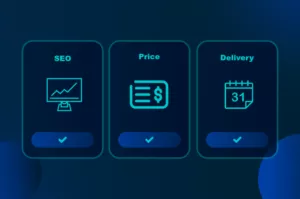The user experience and search engine optimization (SEO) of a website can be greatly impacted by the speed at which a page loads. For web developers, page load speed is more than simply a technical consideration but it’s an essential factor that can influence search engine rankings, conversion rates, and user engagement.

Learning about Page Load Speed
The duration needed for a webpage’s content to load completely on a user’s screen is referred to as page load speed. This covers every aspect, including interactive elements, videos, photos, and text. Numerous metrics can be used to gauge page load speed, including:
- Time to First Byte (TTFB): The amount of time it takes for the first byte of data to arrive in the browser from the server.
- First Contentful Paint (FCP): The duration of time required for the screen to display the first item of content.
- Largest Contentful Paint (LCP): The loading time of the element with the largest apparent size.
- Total Blocking Time (TBT): The amount of time that the browser cannot respond to user inputs.
- Cumulative Layout Shift (CLS): The degree to which items shift during loading and the visual stability of the page.
Each of these metrics sheds light on various facets of the user experience and loading time.
How It Affects User Experience
User experience (UX) is an essential part of a website’s success. Pages that load slowly can seriously impair user experience (UX), with several unfavorable consequences:
- Higher Bounce Rates: When a page loads slowly, users are more likely to leave. Research indicates that over 50% of users will abandon a page before it loads completely if it takes longer than three seconds to load.
- Decreased User Engagement: Information flow can be disrupted by slowly loading pages, which makes it harder for users to interact with the content. Shorter session times and fewer interaction rates may result from this.
- Negative business Perception: People frequently mistake a website’s speed for the expertise and dependability of the business. A sluggish website may give the wrong impression and harm the brand’s reputation over time.
- Accessibility Issues: Content on a slow-loading website may be difficult for users with slower internet connections or less powerful devices to view. This may decrease overall reach and alienate some members of the audience.
How It Affects SEO
Giving users the greatest experience possible is a top priority for search engines like Google. Therefore, a key component of their ranking algorithms is the speed at which pages load. This is the effect on SEO:
- Ranking Signals: Page speed is a ranking component, as stated by Google. Fast-loading websites have a greater chance of appearing higher in search engine results pages (SERPs). This is a component of Google’s larger endeavor to guarantee that customers receive a satisfactory experience when they click on search results.
- Crawl Efficiency: The amount of time search engine bots have to thoroughly examine a website is restricted. The number of pages that the bots can crawl and index in the allotted period may be lowered if pages load slowly. This may have an impact on how visible the website is in search results overall.
- Metrics of User Behavior: Metrics of user satisfaction and engagement include time on site, bounce rate, and pages per session. Search engines may interpret slow page speeds as an indication that the website may not be offering a satisfactory user experience, which can hurt these metrics.
- Mobile Optimization: Mobile page load speed has become even more important as more people utilize mobile devices to browse the internet. Google indexes websites based on their mobile version first, making it the dominant version for indexing and ranking. Thus, slow mobile pages can significantly affect the performance of SEO as a whole.
Methods for Increasing Page Load Speed
It needs both technological optimizations and strategic content management to increase page load speed. Here are a few effective methods:
- Optimize images: A page’s loading speed can be greatly impacted by large images. To decrease file sizes without sacrificing quality, use picture compression software. Optimizing load speeds can also be achieved by using responsive images that change according to the size of the screen.
- Use Browser Caching: By storing frequently requested resources locally on the user’s device, browser caching helps to eliminate the need for repetitive downloads. This can greatly expedite later visits to the website.
- Reduce the Number of HTTP Requests: Every component on a page, including scripts, pictures, and CSS files, needs an HTTP request. Load speed can be increased by employing CSS sprites and merging files to reduce the amount of requests.
- Make use of a Content Delivery Network (CDN): CDNs deliver web material to users from several global servers. This shortens the user-server distance, which speeds up load times, particularly for users from other countries.
- Decrease Render-Blocking Resources: Minimize or postpone any JavaScript and CSS files that obstruct viewing. One way to help with perceived load times is to use asynchronous loading and inline critical CSS.
- Enhance Server Performance: You can improve overall performance by using quicker hosting solutions, upgrading server hardware, and optimizing server-side scripting. Improving TTFB requires reducing server response times.
- Give Priority to Above-the-Fold Content: You can speed up perceived load times by making sure that the content that is visible on the screen without scrolling loads first. While the rest of the page loads, users can begin interacting with the information.
- Use Lazy Loading: This technique waits to load non-essential components, such as videos and photos until they are required. Users’ performance can be enhanced and initial load times can be greatly decreased as a result.
- Monitor and Test Frequently: Using resources like Google PageSpeed Insights, GTmetrix, and WebPageTest, you can monitor and test page speed frequently to help find bottlenecks and monitor progress over time.
Conclusion
One important component that influences both SEO and user experience is page load speed. A website that loads quickly can increase engagement, improve user satisfaction, and improve search engine rankings. Website owners may guarantee that their sites are optimized for speed, giving consumers a seamless and delightful experience, by putting best practices into effect and keeping up with evolving technologies. It is not only technically necessary but also strategically vital to prioritize page load speed in the increasingly competitive digital landscape.
You may optimize your website and more with the aid of F8 Media. In Caloundra, QLD, we are the industry leaders in web design, mobile-friendly websites, eCommerce, digital marketing, and SEO services. We will ensure that every part of your project is finished on schedule and within your allocated budget. Contact us right now to find out more about our services!



